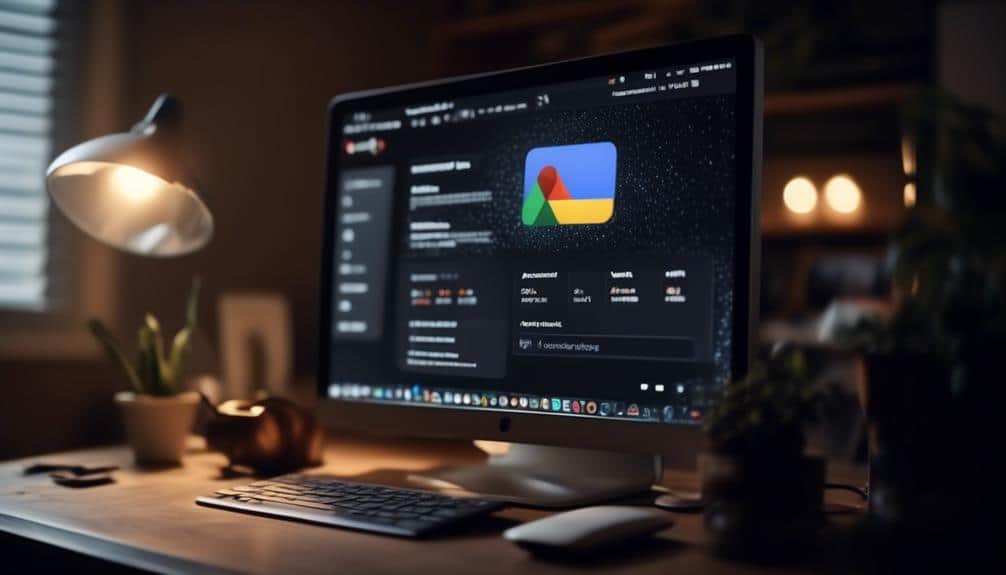Launching Success: A Step-by-Step Guide to Setting Up Your First Google Ads Campaign
When it comes to navigating the intricate world of online advertising, setting sail on your maiden Google Ads campaign can feel like stepping into uncharted waters. You might find yourself grappling with questions about where to start, how to optimize, and when to adjust your course.
However, fear not, for within the pages of this guide lie the navigational tools to steer you towards a successful campaign launch. By unraveling the complexities and breaking down the process into manageable steps, you'll soon realize that mastering Google Ads is more achievable than you may think.
Key Takeaways
- Clearly define campaign goals with measurable objectives.
- Utilize long tail keywords for higher conversion rates.
- Implement conversion tracking for deeper insights.
- Adjust bids based on high-performing keywords.
Defining Your Campaign Goals

When setting up your first Google Ads campaign, it's crucial to clearly define your campaign goals to ensure optimal performance and results. Goal tracking is essential for measuring the success of your campaign. By establishing specific and measurable objectives at the outset, you can track the performance of your ads accurately. Define key performance indicators (KPIs) that align with your overall business objectives. These could include metrics like click-through rates, conversion rates, or return on ad spend (ROAS).
Performance measurement is the cornerstone of evaluating your campaign success. Set realistic goals based on industry benchmarks and past performance data if available. Regularly monitor and analyze the performance metrics to identify areas for improvement and optimization. Adjust your strategies based on the insights gathered from the data to enhance the effectiveness of your ads. Remember, clear goal-setting and continual performance tracking are key factors in achieving a successful Google Ads campaign.
Conducting Keyword Research
To optimize your Google Ads campaign performance, conducting thorough keyword research is essential for targeting the right audience effectively. Start by delving into competitor analysis, identifying the keywords they're using successfully. This can provide valuable insights into what works in your industry and help you refine your own keyword strategy.
When conducting keyword research, don't overlook the power of long tail keywords. While these may have lower search volumes individually, they often have higher conversion rates due to their specificity. Incorporating a mix of broad and long tail keywords can help you reach a wider audience while still capturing those actively searching for your products or services.
Utilize tools like Google Keyword Planner, SEMrush, or Ahrefs to uncover relevant keywords and assess their search volumes and competition levels. Remember, the goal isn't just to drive traffic but to attract quality leads that are more likely to convert. By investing time in comprehensive keyword research, you can lay a solid foundation for a successful Google Ads campaign.
Setting Up Your Google Ads Account

When setting up your Google Ads account, focus on the basics like creating your account and setting up payment methods. Make sure to go through the verification process to ensure your account is ready to start running ads.
Understanding these account setup basics and completing the verification process will set you up for success in your Google Ads campaign.
Account Setup Basics
Setting up your Google Ads account is the first crucial step towards launching successful advertising campaigns. To ensure a smooth account setup process, pay attention to the following key aspects:
- Account Security: Protect your account by setting up two-step verification and regularly reviewing access permissions.
- Payment Options: Choose from various payment methods like credit/debit cards, bank transfers, or automatic payments for seamless transactions.
- Billing Information: Enter accurate billing details to avoid disruptions in your ad campaigns due to payment issues.
- Account Notifications: Stay informed about important updates by configuring notification settings to receive alerts via email or text.
Account Verification Process
Begin by verifying your Google Ads account to unlock the full range of advertising features and capabilities. The verification process ensures account security measures are in place, but it can sometimes pose challenges. Below is a table summarizing common challenges and recommended solutions to streamline the account verification process:
| Verification Process Challenges | Recommended Solutions |
|---|---|
| Verification emails not received | Check spam/junk folders |
| Document verification delays | Contact Google Support |
| Phone number verification issues | Double-check entered number |
| Two-factor authentication problems | Verify correct time settings |
Creating Compelling Ad Copy
Crafting captivating ad copy is essential for capturing the attention of your target audience and driving click-through rates. To create compelling ad copy that resonates with your audience, follow these strategic tips:
- Understand Your Audience: Conduct thorough research to understand your target audience's needs, pain points, and preferences. Use this insight to tailor your ad copy to their specific interests.
- Utilize A/B Testing: Test different variations of your ad copy to see what resonates best with your audience. Use A/B testing to iterate and optimize your messaging for maximum impact.
- Focus on Strong Headlines: Craft attention-grabbing headlines that are concise and impactful. Your headline is the first thing users see, so make it compelling.
- Highlight Unique Selling Points: Clearly communicate the benefits of your product or service in your ad copy. Showcase what sets you apart from the competition to entice users to click.
Setting Your Budget and Bidding Strategy

When determining your budget and bidding strategy for your Google Ads campaign, analyzing your goals and market competition is crucial for optimizing your ad performance. Start by allocating your budget effectively based on your campaign objectives. Consider bidding trends and adjust your budget allocation to areas that yield the best results.
For cost management, closely monitor your campaign's performance metrics and adjust your budget allocation accordingly. It's essential to stay updated on bid strategies that align with your goals and adapt to changing market dynamics. Implement automated bidding strategies to streamline the process and maximize results. Experiment with different bidding approaches to find what works best for your campaign.
Continuously analyze your data to fine-tune your budget allocation and bidding strategy for optimal performance. By staying agile and proactive in your budget allocation and bid strategies, you can drive better results and stay ahead of the competition in the dynamic digital advertising landscape.
Targeting Your Audience
To optimize your Google Ads campaign performance, targeting your audience effectively is key to reaching the right users with your ads. Here are some essential strategies to help you target your audience successfully:
- Audience Segmentation: Divide your target audience into specific segments based on demographics, interests, or behaviors. This allows you to tailor your ads to different groups more effectively.
- Competition Analysis: Research your competitors to understand their targeting strategies and audience engagement tactics. This analysis can provide valuable insights to enhance your own targeting approach.
- Targeting Strategies: Utilize Google Ads' targeting options such as keywords, demographics, location, and interests to refine your audience targeting. Experiment with different strategies to see what works best for your campaign.
- Audience Engagement: Create ad content that resonates with your target audience to increase engagement. Compelling ad copy and relevant landing pages can help drive conversions and maximize the impact of your campaign.
Monitoring Performance Metrics

Begin by setting up key performance indicators (KPIs) that align with your campaign goals and objectives. These metrics will be crucial for performance analysis and data tracking throughout your Google Ads campaign.
Regularly monitor important metrics such as click-through rates, conversion rates, cost per acquisition, and return on ad spend. By analyzing these performance indicators, you can identify what's working well and what needs optimization.
Utilize Google Ads' built-in reporting tools to track these metrics effectively and make data-driven decisions to enhance your campaign's success. Consider implementing conversion tracking to gain deeper insights into how users are interacting with your ads and website.
Additionally, leverage A/B testing to compare different ad creatives, keywords, or targeting options to continually refine your campaign performance. Stay proactive in monitoring your performance metrics to adapt quickly and maximize the effectiveness of your Google Ads campaign.
Optimizing Your Campaign
To maximize the effectiveness of your Google Ads campaign, focus on three key areas:
- Ad Copy Testing to refine messaging
- Keyword Optimization to target the right audience
- Bid Strategy Adjustment to ensure cost-efficiency
By consistently optimizing these aspects, you can enhance your campaign's performance, drive more relevant traffic, and ultimately improve your return on investment.
Stay proactive in analyzing data and making adjustments to stay ahead in the competitive digital advertising landscape.
Ad Copy Testing
Optimize your Google Ads campaign by meticulously testing and refining your ad copy for maximum impact. To boost your ad copy's effectiveness, consider the following strategies:
- Ad Copy Analysis: Dive deep into your ad performance metrics to identify what resonates with your audience.
- Copywriting Techniques: Implement compelling headlines, clear calls to action, and relevant keywords to enhance engagement.
- A/B Testing: Experiment with different ad variations to determine which elements drive the best results.
- Continuous Refinement: Regularly monitor and adjust your ad copy based on insights gained from testing to improve overall campaign performance.
Keyword Optimization
Enhance your Google Ads campaign's effectiveness by strategically optimizing your keywords for maximum visibility and relevance. Utilize negative keywords to refine your targeting and prevent your ads from showing for irrelevant searches.
Organize your keywords into specific ad groups to improve ad relevance and Quality Score. Quality Score is crucial as it directly impacts ad relevance and cost-effectiveness.
By continuously refining your keyword list and monitoring performance metrics, you can enhance your campaign's efficiency. Ensure your ad copy aligns with your chosen keywords to improve Quality Score and ad relevance.
Bid Strategy Adjustment
Now that you have strategically optimized your keywords for maximum visibility and relevance, it's time to fine-tune your bid strategy for optimal campaign performance. To further enhance your Google Ads campaign, consider the following steps:
- Performance Tracking: Regularly monitor key metrics like click-through rates, conversion rates, and cost per acquisition to gauge the effectiveness of your bid strategy.
- Bid Adjustments: Analyze data to identify high-performing keywords and adjust your bids accordingly to allocate more budget towards successful keywords.
- Ad Scheduling: Utilize performance data to schedule your ads during peak times when your target audience is most active.
- Device Targeting: Optimize bids based on device performance to maximize conversions on mobile, desktop, and tablet platforms.
Scaling for Success
To achieve significant growth in your Google Ads campaign, it's crucial to strategically expand your reach and impact through smart scaling techniques. As your campaign matures and you see positive results with your target audience, it's time to consider scaling up your efforts for even greater success. By scaling your campaign effectively, you can maximize your ad performance and reach a wider audience. Here's a strategic approach to scaling your Google Ads campaign:
| Scaling Technique | Description |
|---|---|
| Expand Targeting Options | Identify new keywords, demographics, or locations to broaden your audience reach. |
| Increase Budget | Gradually raise your budget to allocate more funds to high-performing ads. |
| Test New Ad Formats | Experiment with different ad formats like video ads or responsive search ads. |
Frequently Asked Questions
Can I Run Google Ads Campaigns for Multiple Businesses From the Same Google Ads Account?
Yes, you can manage multiple businesses' Google Ads campaigns from the same account. However, ensure proper segregation of campaigns to avoid confusion and maintain account security. Implementing strong security measures is crucial for protecting sensitive business data.
How Can I Ensure My Ads Are Shown to the Right Target Audience and Not Wasted on Irrelevant Clicks?
To ensure your ads reach the right audience, focus on precise audience targeting and continual optimization. Allocate your ad budget wisely for maximum efficiency, analyzing data to refine your strategy and drive better results.
What Are Some Common Mistakes to Avoid When Setting up a Google Ads Campaign?
When setting up a Google Ads campaign, avoid overspending by carefully targeting keywords. Focus on relevancy to your audience, monitor performance metrics, and adjust strategies accordingly. Stay innovative by testing and optimizing continuously.
Is It Possible to Track Offline Conversions Generated From My Google Ads Campaigns?
Yes, you can track offline conversions from your Google Ads campaigns. Utilize offline attribution tools to measure the effectiveness of your online campaigns in driving offline actions. This data-driven approach allows for a comprehensive understanding of your campaign's impact.
How Can I Effectively Test and Optimize Different Elements of My Ads to Improve Performance Over Time?
To effectively test and optimize your ads, focus on ad copy testing and keyword optimization. Conduct A/B testing to compare variations. Use performance tracking data to make data-driven decisions and continuously refine your campaigns for improved results.
Conclusion
Now that you've followed these steps to set up your first Google Ads campaign, you're well on your way to launching a successful advertising strategy.
By defining your goals, conducting research, creating compelling ad copy, and monitoring performance metrics, you can optimize and scale your campaign for continued success.
Keep refining your strategy based on data-driven insights to ensure the best results for your business.
Good luck on your advertising journey!








